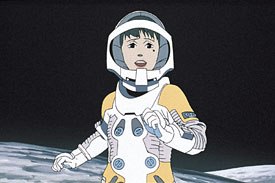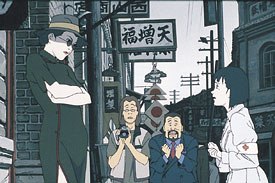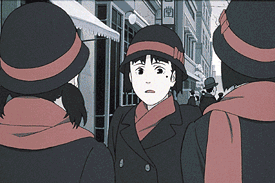Fred Patten takes a look at Japans Millennium Actress and its journey to American movie screens.

The beauty of Millennium Actress. All images courtesy of Go Fish Pictures.
Millennium Actress, one of the best animated features of the new millennium (and likely to remain so, no matter how many more are produced during the next 997 years) has finally come to American theaters although in a release so limited that you will miss it if you blink.
Millennium Actress (Sennen Joyu) is the second critically acclaimed/anime fan favorite theatrical animated feature created by artist/writer/director Satoshi Kon and screenwriter Sadayuki Murai, produced by Tokyos Madhouse studio (best known for Wicked City, Ninja Scroll, Vampire Hunter D: Bloodlust, and some of the sequences in The Animatrix). Their first was the 1997 Perfect Blue, a murder mystery that was likened to an animated Alfred Hitchcock thriller.
Millennium Actress has superficial similarities: Kons distinctive art style; a mystery set within Japans cinematic industry; and a surrealistic viewpoint from inside the heroines mind. But where Perfect Blue emphasized a nightmarish paranoia to make both the heroine and the audience wonder whether she has become a psychotic killer, Millennium Actress is a more benign look into a retired actress bittersweet memories. If Perfect Blue is comparable to Hitchcock, then Millennium Actress is similar to James Camerons Titanic, as an elderly womans flashback of romantic reminiscences, which are so vivid they draw her audience back into the past with her.

Artist, writer and director Satoshi Kon.
It starts with a sci-fi scene very like 2001: A Space Odyssey, but featuring a female astronaut. This turns out to be from a movie being watched by Genya Tachibana, a middle-aged independent documentary filmmaker. It was the final feature made by Chiyoko Fujiwara, Japans greatest actress from the 1930s until the late 1960s when she abruptly vanished into seclusion. Now, 30 years later, Chiyokos old studio has hired Genya to produce a documentary about her. Genya and his brash young cameraman Kyoji Ida track her down and persuade her to give them a personal interview.
As the frail but gracious Chiyoko relives her past, Genya and Kyoji become supporting characters in her memories. These present both a behind-the-scenes look at the Japanese movie industry of this period, and the individual features in which she starred. Viewers in the know will recognize pastiches of Japans greatest films from Throne of Blood to Godzilla, although they work equally well as an enjoyable sampler of Japanese movie genres for viewers who do not know the specific films.

From space to feudal Japan, the film is a tour-de-force of places and eras.
Regarding Chiyokos personal story, it turns out that Genya had met her as a bashful teen assistant on the studio lot just before her final film. He still has a puppy-love crush on her; and although it is not necessary for his documentary, he wants to know the secret of what drove Chiyoko into hiding so long ago.
Filming Millennium Actress in detailed 2D animation, rather than live-action, permits a more seamless transition through the scenes from the real present to the real past to the often jarring contrast of Chiyokos different movie roles. (Animation also enables the monsters and sets in the sci-fi movies to look more realistic than the actual 50s and 60s live-action movies ever did.) This becomes an intellectual puzzle as Genya and Kyoji gradually realize that Chiyokos memories may be more romantically enhanced than what really happened, and they must consciously separate the truth from her idealized view of reality.

Genya and Kyoji get transported into the story of Chiyokos first acting job.
Satoshi Kons Millennium Actress was released at about the same time as Hayao Miyazakis Spirited Away. But while both garnered critical praise the two tied for Japans Agency of Cultural Affairs 5th Media Arts Festival Grand Prize in December 2001 Spirited Away went on to box office success in Japan while Millennium Actress went after international film festival fame. Its world premiere was at Montreals Fantasia 2001 Asiatic fantasy film festival in July 2001, where Kon personally introduced it to a sold-out audience. (It won First Place in the Best Animation Film category, as well as The Fantasia Ground-Breaker Award.) It next played at the Sitges 2001 festival in October, winning the Orient Express Award. Then came the Media Arts Festival in December; a screening in Japan but a limited one.
Millennium Actress Japanese theatrical release did not come until September 14, 2002, in the midst of playing at other international festivals from Singapore to England to Australia to the U.S. (Kon appeared at its screening at the AFI Fest 2002 in Hollywood in November) to Japan again (it won the Best Entry Award in the Theatrical Movie category at the Tokyo International Anime Fair in March 2003). Kon seems to be following this route again with his newest feature: Tokyo Godfathers (also animated by Madhouse) has just had its world premiere at the Big Apple Anime Fest (BAAF 2003) in New York on August 29 - 31, where Kon was a guest of honor.
The publicity went out in August. As part of the recent studio trend, DreamWorks SKG has formed a new specialty division, Go Fish Pictures, with Millennium Actress, the critically acclaimed anime title by Satoshi Kon, as its first release. Millennium Actress opens September 12, 2003 in Los Angeles, New York, Chicago, Boston, San Francisco and Toronto. But it only shows at only one theater in each of those six cities.

Go Fish longs for box office success like Chiyoko longs for her mysterious love.
The announcement goes on to say that Go Fish Pictures expected second release, in spring 2004, will be the anime feature Innocence: Ghost in a Shell II.
Go Fish, considered by DreamWorks as a lab experiment, will look to indie filmmakers and small production companies for product. We are looking for anything that is compelling whether it is animation or live-action, DreamWorks president of distribution Jim Tharp told VFXWorld. While Tharp admits that anime has had a difficult time in the theatrical marketplace (with all of its kudos, Spirited Away was not a commercial success), Go Fish will experiment with Millennium Actress and Ghost to see if it can attain better box office results.
It is very difficult, and we realize that you cant overpay for them, he added. You cant overspend, either, which is why the new specialty division will focus first on targeting the core anime fan base with Millennium Actress before reaching out more broadly if the movie performs in its limited theatrical run. And if it exceeds expectations, Tharp said the studio may even push back the DVD release, which is now scheduled for Oct. 28 through DreamWorks Home Entertainment.
This press release has a resigned air compared with DreamWorks high hopes for Millennium Actress less than a year ago. And why not? Millennium Actress had been winning international film awards for more than a year. Spirited Away, highly publicized in the U.S. by Disney since its limited theatrical distribution began in September 2002, was getting into the news around the country for its record-setting international (outside the U.S.) grosses, its rave reviews and all the prestigious awards that it was garnering.
Spirited Away was up for the 2003 Academy Awards in the new Best Animated Feature Film category. Everyone in the animation industry was hoping that if it won, it would go on to popular success similar to the live-action Crouching Tiger, Hidden Dragon. And DreamWorks hoped that Millennium Actress could quickly follow it.

The epic tale has won acclaim all over the world.
On March 23, 2003, Spirited Away won the coveted Oscar. On the March 28-30 weekend, Disney increased Spirited Aways theatrical distribution from its previous maximum of 151 theaters nationwide to 711 theaters. It was wasted money. Despite all the acclaim, the public was not interested in seeing this foreign theatrical animated feature. Spirited Away had grossed $5,616,071 by the weekend of the Academy Awards presentation. As of September 4, Spirited Aways grosses stood at $10,055,859, meaning that Disneys re-release in more than 500 more theaters brought in less than $4,450,000 more. (Statistics from the Box Office Mojo Website.)

Chiyokos life takes many unexpected turns along the way.
This decisively killed any dreams that Millennium Actress could become a box office hit in America. If the American public could not be convinced that Spirited Away is worth seeing as a delightful family film, it appears impossible to win large audiences for an animated feature about the Japanese movie industry that is not for children.
Considering these strikes against it, DreamWorks is to be congratulated for giving Millennium Actress a theatrical release at all. It is well worth seeing on the big screen, if you are lucky enough to live in one of the six cities showing it. If you are not, dont miss the DVD release. Critics from animation and major consumer publications and newspapers in the U.S. are enthusiastic, giving it high praise. Some are even calling it a contender for the animation theatrical Oscar.
Main Credits
Director/original story/co-screenwriter/character design Satoshi Kon ![]()
Co-screenwriter Sadayuki Murai
Producer Chiyoko Committee
Exec producer Taro Maki
Planning Masao Murayama
Character design/animation director/editor Takeshi Honda
Animation directors Toshiyuki InoueHideri HamsauIkenichi KonishiShogo Furuya
Art director Nobutaka Ike
Director of photography Hisao Shirai
Original music by Susumu Hirasawa
Animation studio Madhouse
Animation produced by Genco, Inc.
Voice Cast
Chiyoko Fujiwara (in her 70s) Miyoko Shoji
Chiyoko Fujiwara (in her 20-40s) Mami Koyama
Chiyoko Fujiwara (in her 10-20s) Fumiko Orikasa
Genya Tachibana Shozo Iizuka
Eiko Shimao Syouko Tsuda
Kyoji Ida Masaya Onosaka
The Man with the Scar Masane Tsukayama
The Man of the Key Kohichi Yamadera
Otaki Hirotaka Suzuoki
Mother Hisako Kyoda
Fred Patten has written on anime for fan and professional magazines since the late 1970s. He wrote the liner notes for Rhino Entertainments The Best of Anime music CD (1998), and was a contributor to The World Encyclopedia of Cartoons, 2nd Edition, ed. by Maurice Horn (1999) and Animation in Asia and the Pacific, ed. by John A. Lent (2001).







